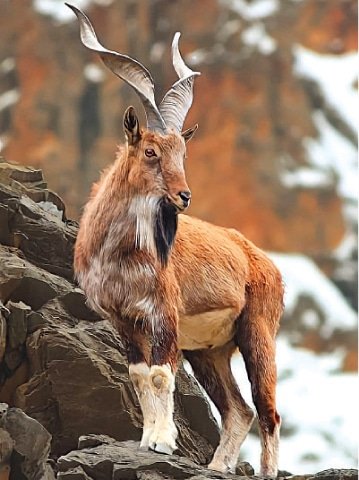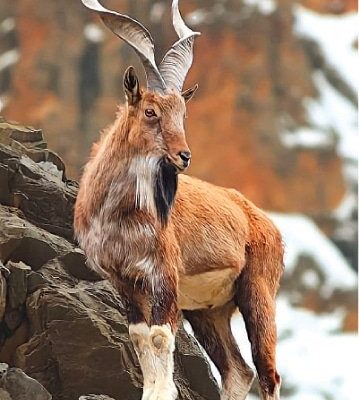
In this article, I’ll delve into ten animals that share characteristics with the markhor. We’ll explore their unique features and how to distinguish them from one another. Whether you’re an animal lover, a curious learner, or just looking to expand your knowledge, this exploration is for you. So, grab a cup of coffee, and let’s hop into the world of these fascinating creatures!
1. Nubian Ibex
The **Nubian ibex** is a striking creature, often found in the mountains of northern Africa and the Middle East. Just like the markhor, these goats are known for their impressive curved horns that can reach up to four feet in males. Their stocky frame and sandy-colored coat help them blend into rocky terrains, making them skilled climbers.
So, how can you tell a Nubian ibex apart from a markhor? For starters, take a closer look at the horns. While both feature similar curls, the Nubian ibex’s horns are generally thicker and shorter. Plus, the Nubian ibex has a more rounded face compared to the elongated snout of the markhor.
2. Alpine Ibex
Next on the list is the **Alpine ibex**, another impressive member of the goat family. Found in the European Alps, these animals are famous for their climbing prowess and thick, shaggy fur. They can often be seen scaling steep cliffs, which is quite a sight!
While Alpine ibexes share a similar habitat with markhors, their differences are notable. The Alpine ibex has longer, straighter horns that curve slightly backward, contrasting with the markhor’s spiral shape. Their coat color can also vary from grayish-brown to lighter shades, which can help in identifying them in the wild.
3. Tahr
If you’ve ever heard of the **tahr**, you might know it as the rugged goat that resembles a small version of a markhor. These animals are native to the Himalayas and surrounding areas, making them quite similar in habitat.
Tahr are known for their long, shaggy fur and distinctive beards, which give them a somewhat majestic appearance. The key difference here? Their horns are not as spiraled as a markhor’s; instead, they are more straight and can appear slightly flattened. Also, the tahr has a more robust and compact body, which makes it distinct from the slender markhor.
4. Sika Deer
The **sika deer** may seem a bit out of place on this list, but they share the same mountainous habitats as the markhor in parts of Asia. These deer are graceful and agile, known for their spotted coats, which provide excellent camouflage in the forest underbrush.
You might wonder how to differentiate a sika deer from a markhor. The difference is quite clear when you observe their body shapes. Sika deer have a more delicate appearance with long legs and a smaller frame, unlike the muscular build of the markhor. Plus, their antlers, which are branched, sport a vastly different design compared to the spiral horns of the markhor.
5. European Chamois
Another noteworthy relative is the **European chamois**, which thrives in the mountainous terrain of Europe. Chamois are smaller than markhors but share similar adaptations for their rocky environments, such as their strong legs and excellent balance.
To tell them apart, look at their horns. Chamois have short, backward-curved horns that are quite different from the markhor’s signature twist. Additionally, the chamois’ fur is typically a dark brown color with lighter patches, giving it a distinct look compared to the markhor’s more uniform coat.
6. Serow
Meet the **serow**, a unique animal found in Asia, particularly in the Himalayas and surrounding regions. These goats have a stocky build and are great climbers, much like the markhor.
What sets the serow apart is its short, straight horns and bushy tail, which aren’t commonly observed in other goat species. While both the serow and markhor are robust, the serow typically has a more compact body and a shaggy coat that varies in color, often displaying a mix of brown and gray shades.
7. Barbary Sheep
Also known as **aoudad**, the **Barbary sheep** is another cousin of the markhor, found in North Africa. These animals are known for their impressive horns that can form a wide curve similar to the markhor’s.
However, the Barbary sheep has a bulkier frame and a lighter, more tawny coat. When viewing them, you’ll also notice they have a distinctively shorter face and a thicker neck, giving them a more muscular appearance compared to the sleek markhor.
8. Rocky Mountain Goat
The **Rocky Mountain goat** might just be the most adaptable climber of them all. Native to the mountains in North America, these goats have thick white fur and long, straight horns that can be easily distinguished from a markhor’s spiral horns.
Despite their family ties, these goats have a stockier build and a fluffy coat that stands out in snowy environments. You’ll often spot them on steep cliffs, showcasing agility that rivals the markhor’s climbing skills!
9. Oreamnos
**Oreamnos** is the scientific genus for goats often referred to as mountain goats. These animals are similar in habitat and behavior to both the markhor and Rocky Mountain goats, excelling at scaling rocky terrains.
To differentiate Oreamnos from markhors, observe their woolly white coats and significantly straighter horns. While both are excellent climbers, the Oreamnos shows a more rounded silhouette, adding to its charm as a mountain dweller.
10. Dall Sheep
Last but not least, we have the **Dall sheep**, native to the rugged terrains of Alaska and Canada. These sheep are known for their stunning white coats and uniquely curled horns, which are quite different from the markhor’s spiral structure.
When comparing them, you’ll notice that Dall sheep tend to have a more slender body and a finer face, which contributes to their graceful appearance. Their horns are also more spiral than a markhor’s, giving them a distinctive look.
In conclusion, while the markhor certainly stands out with its dramatic horns and rugged beauty, it’s fascinating to discover the variety of animals that share similar traits. From the Nubian ibex to the graceful Dall sheep, each of these creatures has its own story and charm. Whether you’re an avid wildlife enthusiast or just curious about nature, these comparisons offer a glimpse into the fascinating world of mountain-dwelling animals!

